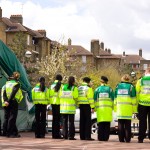 Incident Management Team – Logistics Section Chief
Incident Management Team – Logistics Section Chief
Over the weekend (May 10th 2014), I participated in an Incident Management Team for the Starved Rock Country Marathon, held in Ottawa, Illinois. During the marathon, I was Logistics Section Chief. The Logistics Section Chief is responsible for providing facilities, services and materials in response to an incident. In this case, the incident was the marathon and my responsibility was to support any emergencies that the event staff could not correct.
Typically, Incident Command is used for management of emergency incidents. It can also be used as a pre-plan for a non-emergency event. An overview of the Incident Command System is shown below, as defined by FEMA.
The Incident Command System (ICS) is a standardized, on-scene, all-hazards incident management approach that:
- Allows for the integration of facilities, equipment, personnel, procedures and communications operating within a common organizational structure
- Enables a coordinated response among various jurisdictions and functional agencies, both public and private
- Establishes common processes for planning and managing resources
ICS is flexible and can be used for incidents of any type, scope and complexity. ICS allows its users to adopt an integrated organizational structure to match the complexities and demands of single or multiple incidents.
ICS is used by all levels of government—federal, state, tribal and local—as well as by many nongovernmental organizations and the private sector. ICS is also applicable across disciplines. It is typically structured to facilitate activities in five major functional areas: Command, Operations, Planning, Logistics and Finance/Administration. All of the functional areas may or may not be used based on the incident needs. Intelligence/Investigations is an optional sixth functional area that is activated on a case-by-case basis.
As a system, ICS is extremely useful; not only does it provide an organizational structure for incident management but it also guides the process for planning, building and adapting that structure. Using ICS for every incident or planned event helps hone and maintain skills needed for the large-scale incidents.
Since ICS was used for this event, there was a significant amount of planning, prior to the event, including the development of an event Incident Action Plan (IAP). According to FEMA, the IAP is a written plan that defines the incident objectives and reflects the tactics necessary to manage an incident during an operational period.
The day was uneventful and in an event, uneventful is great. To make the day uneventful, this is how we prepared.
- We met each week, 4 times prior to the event, starting in early April
- For these meetings we included over 20 representatives from local hospitals, event organizers, Fire, Police and EMS responders
- We determined who the race would impact which was the runners, the communities that were part of the race route and how it would impact our team of 20 representatives
- We first started out with the objectives for this event. The objectives were approved by the Incident Commander, in this case me
The objectives for the event were:
o Ensure an orderly and safe event
o Protect the health and safety of the marathon participants and citizens
o Monitor the event and maintain a constant state of situation awareness and operational readiness
o Work closely with event organizers, local hospitals, city and county agencies for a unified response during the race
Once the objectives were identified, we discussed the following:
- The “what if’s” that could happen
- Needed resources, such as how many law enforcement personnel, ambulances, fire personnel, aid station locations and so on to cover the race
- Aid station supplies and to radio for more supplies when supplies are low and BEFORE supplies run out
- Location/placement of resources throughout the race
- Communication, we decided on radio communication and then we identified “dead zones” and decided on Amateur Radio frequencies to overcome those dead zones
- We then developed detailed plans and assignment lists that supported our objectives
- We utilized the ICS forms to document our plan. These documents were then used to assemble our Incident Action Plan
The day of the race, our operational period was 6 am to 3 pm. We started the morning of the event with a briefing at 5:45. This brief was to ensure that everything was in place and to review any last minute updates to the IAP. The marathon was to start at 7 am. The actual start time was 7:10 which, considering there were in excess of 1000 runners, a ten minute delay was good.
We monitored the communications from event volunteers as well as the Fire, Police and EMS responders stationed throughout the race route. In addition to our Fire, Police and EMS radios, we monitored Amateur Radio frequencies for our dead zones.
Outside of a couple of minor requests, such as “where is the porta potty located”, “we are running out of cups at the aid station” and automobile drivers not paying attention to the runners, the day was uneventful. We terminated command around 2 pm, which was an hour ahead of time.
We were prepared for any emergency situation that was probable to the event and our geographic location. The weather was great and the pre-planning for this event helped make the event a safe one for the runners, volunteers, emergency personnel and the community. The use of the Incident Command System for this event ensured that we managed the event, not the event managing us.











